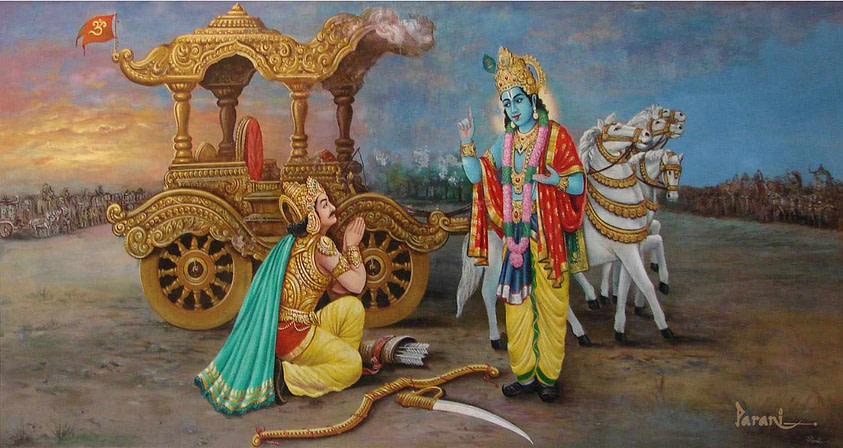Chapter 12 – Saguna and Nirguna Bhakti
Summary :
Importance of Bhakti
This is a small Chapter with only twenty verses; but it is as sweet and life-giving as a spring of nectar. The Lord has Himself eulogized ( praised) here the greatness of bhakti.
Sagun Bhakta and Nirgun Bhakta
Arjun asks Lord Krishna,“Some devotees worship you in saguna form while others worship you in nirguna form. Whom do you like more?”
Both bhaktas are identical.Both are equally loved by Lord Krishna.
In 5th Chapter Arjuna had asked a similar question.He asked which yoga is superior between Karma Yoga and Sanyas Yoga?Bhagawan answered,” both of them reach the same destination of the Moksha. However Karma Yoga is easier to practice for common people so it is slightly better.”
The question of choice between saguna and nirguna is similar. The saguna devotee serves the Lord through his organs, whereas the nirguna devotee thinks of the good of the whole world. The former appears absorbed in outward service, but his mind is absorbed in the contemplation of the Lord. The latter does not appear to be rendering any concrete service, but he is certainly rendering a great service from within. Which one of these two devotees is superior? These two types of devotees may appear outwardly different, but they are intrinsically one and the same. Both of them are dear to the Lord. But saguna bhakti is easier. The answer given here is similar to the one given in the Fifth Chapter
Saguna is easy and Safe
For the saguna devotee, his organs are the means (to realize the Lord). They are like flowers that are to be offered to the Lord. With his eyes he beholds His form; with his ears, he listens to His praise and His edifying stories; with his mouth, he chants His Name. He uses his legs for pilgrimage and hands to render service. In this way, he dedicates all the organs of perception and action to the Lord. For him, they are no longer the means for enjoyment. The flowers are there to be offered to the Lord; one should not put garlands around one’s own neck. Likewise, the organs should be used in the service of the Lord. This is the outlook of the saguna devotee.
But to a nirguna devotee they appear to be a hindrance. He restrains them, starves them, keeps a watch over them. The saguna devotee feels no need to do so. He surrenders them at the feet of the Lord. Both these are methods of controlling the organs. Whatever be the way, it is imperative to restrain them and prevent them from wallowing in the pleasures of the senses. But one way is easier while the other one is difficult.
Nirguna devotees are dedicated to the good of all. This is no ordinary thing; it is easier said than done. One who is absorbed in thinking about the good of the whole world can do nothing else. Hence nirguna sadhana is difficult. Saguna worship, on the other hand, can be done by anybody according to his capacity. To serve the small village we are born in or to look after our parents is a form of saguna worship. Such service should, of course, not go against the interests of the world..
Apart from the point of easiness, there is one more point. Nirguna worship is fraught with some risk. Nirguna is all knowledge (Jnana). But saguna is full of love and tenderness and the warmth of feelings. A devotee is more secure there.Nirguna has some amount of risk.
Saguna needs help from nirguna. One must eventually learn to free oneself from attachment to and preoccupation with individuals and outer forms. For example,while constructing an arch, support is given to it; but the support has to be withdrawn later. If the arch remains firmly in place after the support is removed, the support can be said to have done its work. Saguna is indeed the source of inspiration, but the ultimate culmination must be in nirguna,in commitment to principles. Self-knowledge must ultimately emerge from the womb of devotion. The plant of bhakti must blossom into the flower of Self-knowledge.
There is image-worship, in some form or the other, in all the religions including Hinduism, Islam and Christianity. Although it is not considered the highest form of worship, it has been accepted and respected. As long as it remains within the bounds set by nirguna, it remains free from defects. As soon as it crosses these bounds, defects appear in it. This has happened in all the religions—saguna therein has degenerated in the absence of restraint from nirguna. Animal sacrifice was prevalent in yajnas and other rites in ancient times, and even today animals are sacrificed to Goddess Kali. It is a travesty ( distorted representation) of image-worship. It means that image-worship has crossed the bounds and has gone astray. This risk is averted if saguna is restrained by firm commitment to nirguna
To sum up, saguna and nirguna are complementary to each other. Saguna is easier than nirguna.The Lord says in the end, “O, Arjuna! You may prefer saguna or nirguna, but be a bhakta (devotee); do not remain untouched by devotion.” And then the Lord describes the characteristic attributes of bhakta. The nectar may be sweet, but we have never tasted it. The verses describing the bhakta’s attributes, however, have a rare sweetness that we can experience directly. These verses should be read daily, reflected upon, ruminated over again and again. We should try to imbibe these attributes bit by bit and go on enriching our life; and thus lead it gradually towards the Lord.

